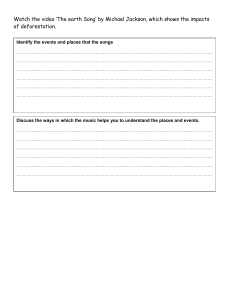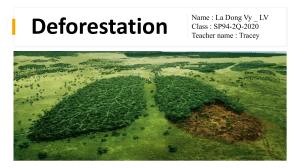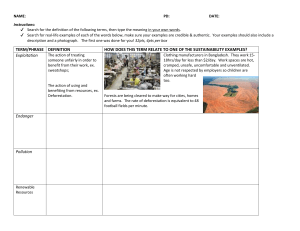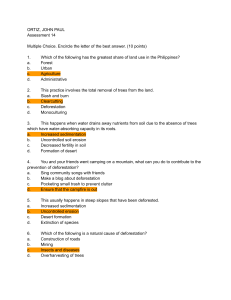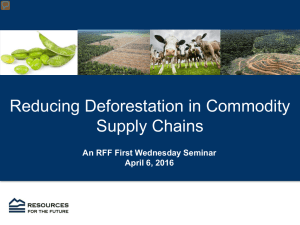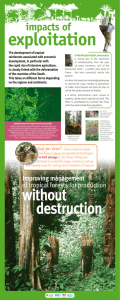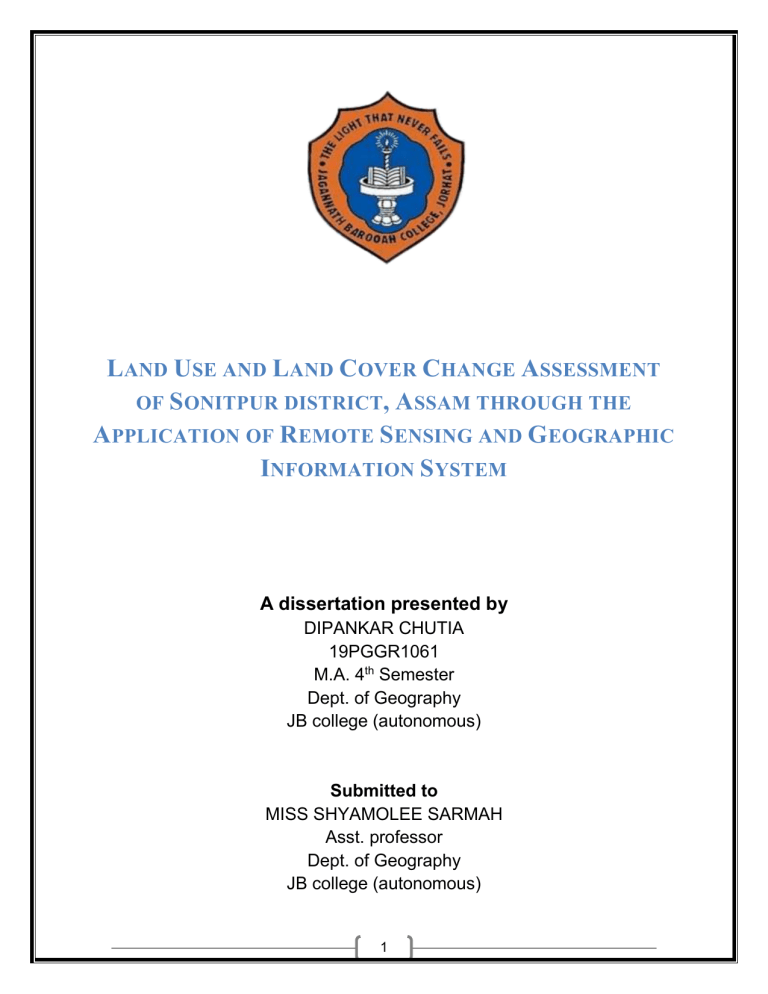
LAND USE AND LAND COVER CHANGE ASSESSMENT OF SONITPUR DISTRICT , ASSAM THROUGH THE APPLICATION OF REMOTE SENSING AND GEOGRAPHIC INFORMATION SYSTEM A dissertation presented by DIPANKAR CHUTIA 19PGGR1061 M.A. 4th Semester Dept. of Geography JB college (autonomous) Submitted to MISS SHYAMOLEE SARMAH Asst. professor Dept. of Geography JB college (autonomous) 1 CERTIFICATE This is to certify that the dissertation entitled Land use and land cover change assessment of Sonitpur district, Assam, through the Application of Remote Sensing and Geographic Information System, submitted to the Department of Geography, Jagannath Barooah College, in partial fulfillment for the award of the degree of Master of Geography, is a record of work carried out by Dipankar Chutia, Roll No. 19PGGR1061 under the guidance and supervision of Miss Shyamolee Sarmah. No part of this dissertation has been submitted elsewhere for award of any other degree. Place: Date: Signature of the Supervisor Name of the Supervisor MISS SHYAMOLEE SARMAH Asst. professor Dept. of Geography JB college (Autonomous) 2 ACKNOWLEDGEMENT I take this opportunity to express my profound gratitude and deep regards to my teacher Miss. Shyamolee Sarmah ma'am for her exemplary guidance, monitoring and constant encouragement throughout the course of this report work. I'm grateful for help and guidance given by her throughout the time. Beside my teacher, I would like to thank my friends for helping me out. Lastly, I thank my parents for their constant encouragement and support either morally or financially without which this project would not be possible. Dipankar Chutia 19PGGR1061 M.A. 4th Semester 3 TABLE OF CONTENTS 1. 2. ● ● ● ● ● ● ● 3. ● ● 4. ● ● 5. ACKNOWLEDGEMENT ---------------------------- 3 CHAPTER 1 ------------------------------------------- 5 - 13 Introduction -------------------------------------------- 5 Statement of the problem -------------------------- 6 Study area --------------------------------------------- 6 - 7 Objectives of the study ----------------------------- 8 Literature review ------------------------------------- 8 - 9 Data used and methodology ---------------------- 10 Limitations of the study ----------------------------- 11 CHAPTER 2 ------------------------------------------- 12 - 15 Results and discussion ----------------------------- 12 - 13 Land cover change detection --------------------- 14 - 15 CHAPTER 3 ------------------------------------------- 16 - 18 Findings ------------------------------------------------ 16 - 17 Conclusion --------------------------------------------- 18 REFERENCE ----------------------------------------- 18 4 CHAPTER 1 INTRODUCTION Land is the most important natural resources on which all activities are based. Land cover indicates the physical land type such as forest or open water whereas land use documents how people are using the land. Land cover refers to the surface cover on the ground, whether vegetation, urban infrastructure, water, bare soil or other. Land cover can be determined by analyzing satellite and aerial imagery. Land cover is important for global monitoring studies, resource management, and planning activities. Land use shows how people use the landscape whether for development, conservation, or mixed uses. Land use applications involve both baseline mapping and subsequent monitoring. Land Use Change is responsible for 18% of global greenhouse gas emissions, principally from deforestation. 58% of deforestation is due to commercial agriculture Land Use Change. The knowledge of land use will help develop strategies to balance conservation, to deal with deforestation problems and developmental pressures. The rapid growth of human population, expansion of urban centres, scarcity of land, the need for more production, technological development, etc. are the main reasons responsible for the land use and land cover changes in the present world. Thus, to prepare integrated plans for optimal utilization of natural resources, it is necessary to have adequate information regarding land use and land cover of a certain area. In this paper I will try to assess the spatiotemporal changes of land use and landcover patterns of Sonitpur district in Assam using geospatial techniques. Remote Sensing and Geographic Information System are effective techniques for estimating forest cover change. These techniques are used extensively for generating valuable information on forest cover ares, land use changes over large areas and protected areas. 5 STATEMENT OF THE PROBLEM Deforestation is an important issue that causes trees to be cut down to provide more land. It can lead to climate change, desertification, soil erosion, flooding, increased greenhouse gases etc. Deforestation occurs for several reasons, including farming, wood extraction, infrastructure expansion such as road building and urbanization, livestock ranching, illegal logging etc. Therefore, I want to find solutions to some of the problems of deforestation in Sonitpur District. The problems are, whether deforestation lead to flooding? The causes of deforestation in Sonitpur district. And also, I’ll try to figure out the measures being made to control deforestation. STUDY AREA Sonitpur district lies on the plains between the foothills of the Himalayas and the valley of the Brahmaputra which forms its southern border. It lies between 92°57′ E to 93° E longitude and 26° 50' N to 27°01'N latitude. The district is surrounded by Arunachal Pradesh in north, Lakhimpur district in east, Darrang districts in west, Brahmaputra River in the south comprising a total area of 5204.87 km2. The drainage system of the district falls into the Brahmaputra with Ziabharali and Gabharu. According to 2011 census, the district is inhabited by 1,924,111 population representing 6.17% of Assam. The climate of Sonitpur district falls under sub-tropical monsoon type wherein the average temperature ranges between 11.4 ̊C to 32.6 ̊C. Sonitpur District is home to several wildlife sanctuaries and national parks. In 1998, Sonitpur district became home to Nameri National Park in the north, which has an area of 200 km2 (77.2 sq mi). It is also home to Orang National Park, which it shares with Darrang district. Orang 6 National Park was established in 1999 and has an area of 79 km2. Sonitpur is home to two wildlife sanctuaries: Burachapori Wildlife Sanctuary and Sonai Rupai Wildlife Sanctuary. Fig 1: Map of the study area 7 OBJECTIVES There are two prime objectives of this study: ● Monitoring the causes and impact of deforestation in Sonitpur district. ● To assess the land use and land cover change over the period of 6 years from 2008 to 2014. LITERATURE REVIEW Topic: Land Use and Land Cover Change Assessment of Sonitpur district, Assam Using Geospatial Techniques Authors: Debashree Borah, Saraswati Bhattarai & Durlov Lahon Objective The research aims to assess the LULC change pattern of Sonitpur district over a period of 20 years from 2000 to 2020 on Arc GIS platform. The results of the study would support and enhance the decision and policy makers to implement and formulate strategies to achieve sustainable development of the available resources. Topic: Assessment of large-scale deforestation in Sonitpur district of Assam Authors: Shalini Srivastava, T. P. Singh, Harnam Singh, S. P. S. Kushwaha and P. S. Roy 8 Objective The study highlights the deforestation and encroachment in the moist deciduous and other forest areas in Sonitpur District of Assam. Topic: Assessing the tropical forest cover change in northern parts of Sonitpur and Udalguri district of Assam, India Authors: Ranjit Mahato, Rajiv Gandhi University. Gibji Nimasow, Rajiv Gandhi University. Oyi Dai Nimasow, Rajiv Gandhi University; Dhoni Bushi, Rajiv Gandhi University. Objective The protected areas of Nameri National park, Sonai Rupai wildlife sanctuary reportedly facing the problem of encroachment and large-scale deforestation. So, this study attempts to estimate the forest cover change in the area through integrating the remotely sensed data of 1990, 2000, 2010, and 2020 with Geographic Information System. 9 DATA USED AND METHODOLOGY The study is carried out with the help of Remote Sensing data. Data I've collected are mostly from the internet. Some websites that I used for collecting data are wikipidia.com, bhuvan.nrsc.govt.in, researchgate.com etc. After the collection the processing of datasets are computed in ERDAS and QGIS software with some sequential steps. The methodogical flowchart of those sequential steps are shown below in fig 2. Fig 2: Flow chat of methodology 10 LIMITATION OF THE STUDY There are few drawbacks of my study which are listed below: ● The period of this study is not sufficient. The study period is from 2008 to 2014. This means this study only shows the transformation within 6 years. ● This study is not up to date. The assessment is till 2014 so it is outdated. That's why practical uses or real life uses of this study will be not valuable. We only can use it for study purposes. 11 CHAPTER 2 RESULTS AND DISCUSSION Based on LULC classification the area is divided into 6 major classes. This are water body, forest, sand bar, vegetation, agricultural land and build up area for the years 2008 and 2014 which are shown in fig 3 and 4. The results reveal a considerable loss of forest cover in the study area. If we compare this result, we can clearly see the occurrence of deforestation. Places near the Nameri national park, Behali reserved forest, Sonai Rupai wildlife sanctuary faces huge deforestation. There is also significant increase in agricultural sector in 2014. The growth of the agricultural land can be seen all over the Sonitpur district. The water bodies classes have experienced a growth over 6 year due to erosional activities by river Brahmaputra.There is sharp increase in buildup area in 2014. Rampant build up area growth in 2014 has led to decrease in vegetation. The forest class and sand bar class face a remarkable decrease in the year 2014. Some forest area turns into vegetation like grassland or bushes in the year 2014. 12 Fig 3: LULC classified map of Sonitpur district 2008 Fig 4: LULC classified map of Sonitpur district 2014 13 Land cover change detection The computed change detection is shown in the figure 4, 5 and 6. Fig 1 showing 10% increase and decrease, fig 2 showing 20% increases and decrease and fig 3 showing 30% increase and decrease in the classes. The red 5 indicates the decreasing and the green colour indicates the increase in change detection of the LULC classes. Fig 4: 10% change detection 14 Fig 5: 20 percent change detection Fig 6: 30 percent change detection 15 CHAPTER 3 FINDINGS AND CONCLUSION Findings i. The LULC maps reveal striking changes over the periods particularly in agriculture and forest sectors. There is sharp decrease in the forest sector and significant increase in the agricultural sector. ii. These changes are triggered by various factors such as population growth, industrialization, deforestation etc. iii. The study reveals that agriculture is the number one cause of deforestation. During the year 2008 vegetation had the largest share of land along with forest class, but in 2014 crop land holds the highest share. It is due to the conversion of grassland and forest into agricultural area. iv. In this study, we also found significant Hotspots of deforestation in Sonai Rupai Wildlife Sanctuary and Nameri National Park mainly due to illegal encroachment for human habitation and conversion into agricultural land. v. The human settlement around the protected areas have also suffered a significant forest cover loss. 16 vi. Growth in buildup area is noticeable. The constructions of human infrastructures also been driving deforestation. vii. The vegetation class of eastern and northern area of Sonitpur in 2008 is further transformed into build up area and crop land in 2014. viii. Vegetation and forest areas in the bank of Brahmaputra river have been also reduced considerably during the period of 2014, as a result there is slight increase in the class of water bodies, where Brahmaputra river is working as an erosional factor. 17 Conclusion Mapping of LULC and change detection using remote sensing and GIS techniques is a cost-effective method of obtaining a clear understanding of the land cover alteration processes due to land use change and their consequences. LULC maps help us to study the changes that are happening in our ecosystem and environment. The resultant map of the present study has classified the area into 6 classes and all of them witnessed positive and negative variations. This study shows the enormous growth of agricultural land and build up area due to deforestation. The decrease of both forest and vegetation indicates the rise rise of population in Sonitpur district. Apart from expansion of agricultural lands, cutting of trees for timber and fuelwood are the other contributing factors of deforestation. The assessment of land use land cover change is essential to understand forest dynamics like afforestation and deforestation in an area. This study concludes with a suggestion for the early declaration of Sonai Rupai Wildlife Sanctuary and its nearby areas as eco sensitive zones to control and minimize the present trend of deforestation. ------------------------------------ 18 References 1. Debashree Borah, Saraswati Bhattarai & Durlov Lahon; Land Use and Land Cover Change Assessment of Sonitpur district, Assam Using Geospatial Techniques; 2020; Assam, India 2. Shalini Srivastava, T. P. Singh, Harnam Singh, S. P. S. Kushwaha and P. S. Roy; Assessment of large-scale deforestation in Sonitpur district of Assam;Symbiosis International University, Indian Institute of remote Sensing, ISRO, Dehradun, India, Intergraph SG & I India Pvt. Ltd. 3. Ranjit Mahato,Gibji Nimasow,Dhoni Bushi; Assessing the tropical forest cover change in northern parts of Sonitpur and Udalguri district of Assam, India; Rajiv Gandhi University 4. Rane Gauri and Joshi Bhushan, Land use/land cover mapping using remot sensing and geographic information system, J. Environ. Res. Develop. 5. Ranjit Mahato, Gibji Nimasow, Oyi Dai Nimasow, Dhoni Bushi; Assessing the tropical forest cover change in northern parts of Sonitpur ans Udalguri Districts of Assam, India. 6. https://www.researchgate.net/figure/Land-use-land-covermap-of-a-1991-b-2010-c-2014_fig3_310816627 19
